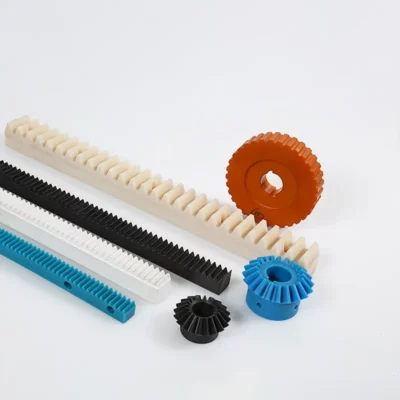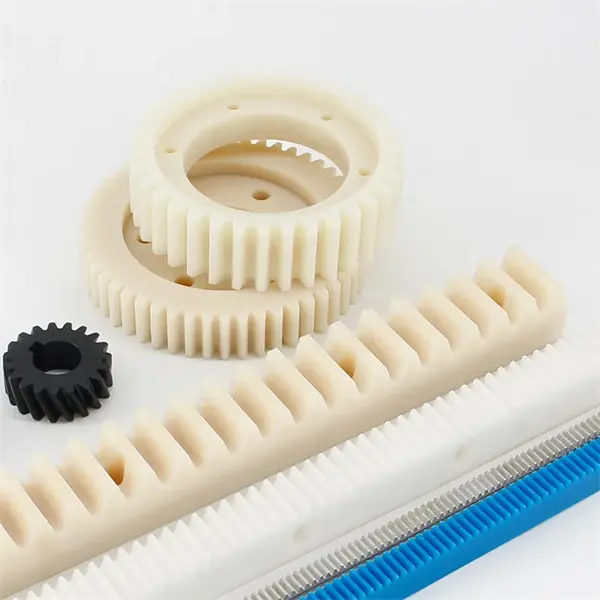Product Description
Great Precision Gear Rack and Pinion From HangZhou Wen ling China Factory
Product Description
Click the picture to learn more
|
Spur gear |
Helical gear |
Double helical gear |
|
Miter gear |
Spiral Bevel Gear |
Straight bevel gear |
|
Internal gear |
Worm gear & worm shaft |
Gear rack |
We can produce large forging,casting and welding gears according to customer’s drawings.According to the working conditions and clients’ request,we also can do gear grinding,surface hardening,cemented and quenching,Nitriding and quenching,etc.
|
Material |
C45,40Cr,20CrMnTi,42CrMo, Copper, Stainless steel and so on as per your requests. |
|
Processing |
F.orging, Machining, Hobbing, Milling, Shaving, Grinding, Heat treatment….… |
|
Heat Treatment |
Carburizing,Induction,Flame,Nitriding….… |
|
Main Machines |
NC Gear Hobbing Machines, NC Gear Shapers(Gealson, Moude), NC lathe, NC gear Shaving machines, NC gear milling, Nc gear grinding |
Our company specializes in manufacturing custom-made large-scale gears for various industrial applications, employing advanced forging, casting, and welding techniques as per our clients’ exact specifications and technical drawings. We take pride in our ability to create gears that not only meet but exceed expectations in terms of durability and performance under demanding working conditions.
In addition to precision fabrication, we offer an array of post-processing services tailored to enhance gear longevity and functionality. These value-added treatments include:
-
Gear Grinding: Ensuring exceptional surface finish and high accuracy of tooth profiles for smoother operation and reduced noise.
-
Surface Hardening: Applying processes like induction hardening or flame hardening to form a hardened wear-resistant surface layer while preserving a tough interior core, ideal for gears subject to high loads and surface wear.
-
Cementation (Carburizing): A heat treatment process where carbon is diffused into the surface of the gear to increase its hardness, enhancing load-bearing capabilities without compromising toughness.
-
Quenching: Rapid cooling after heating to achieve the desired microstructure and mechanical properties, thereby improving hardness and strength of the gears.
-
Nitriding and Quenching: Nitriding involves introducing nitrogen into the surface layer to create a hard and wear-resistant case, often followed by quenching to further refine the material’s properties. This combination results in gears with superior fatigue resistance and improved service life.
Each of these processes is meticulously executed under strict quality control measures to ensure that every gear component produced meets stringent standards and client requirements. Our commitment to customization allows us to cater to diverse industries and unique operational environments, providing customers with gears that are specifically designed and treated to withstand their specific application demands.
/* January 22, 2571 19:08:37 */!function(){function s(e,r){var a,o={};try{e&&e.split(“,”).forEach(function(e,t){e&&(a=e.match(/(.*?):(.*)$/))&&1
| Application: | Motor, Electric Cars, Motorcycle, Machinery, Marine, Toy, Agricultural Machinery, Car |
|---|---|
| Hardness: | Hardened Tooth Surface |
| Gear Position: | Internal Gear |
| Manufacturing Method: | Cast Gear |
| Toothed Portion Shape: | Spur Gear |
| Material: | Stainless Steel |
| Samples: |
US$ 9999/Piece
1 Piece(Min.Order) | |
|---|
| Customization: |
Available
| Customized Request |
|---|

Can rack and pinion systems withstand variations in environmental conditions?
Rack and pinion systems are designed to operate reliably under various environmental conditions. Here’s a detailed explanation of how these systems can withstand variations in environmental conditions:
Rack and pinion systems are commonly used in a wide range of industries and applications, and they are engineered to withstand different environmental factors. Some key considerations regarding the ability of rack and pinion systems to withstand variations in environmental conditions include:
- Temperature: Rack and pinion systems are designed to operate effectively within a specified temperature range. The materials chosen for the components should be capable of withstanding both high and low temperatures without significant degradation. For example, steel or stainless steel components can handle a wider temperature range compared to certain plastics. In extreme temperature conditions, additional measures such as insulation or cooling systems may be required to ensure optimal performance.
- Humidity and Moisture: Rack and pinion systems can be designed to operate in environments with high humidity or moisture. Materials with good corrosion resistance, such as stainless steel or certain plastics, are often used to minimize the risk of rust or degradation due to moisture exposure. Proper sealing and protective coatings can also be applied to sensitive components to prevent water ingress and maintain system integrity.
- Dust and Particles: In environments where there is a presence of dust, dirt, or other particles, rack and pinion systems can be designed with protective measures. Sealed enclosures, gaskets, or covers can be employed to minimize the entry of contaminants into the system. Choosing materials with low friction properties can help reduce the accumulation of particles on the gear surfaces, ensuring smooth operation and minimizing wear.
- Chemical Exposure: Rack and pinion systems may encounter exposure to various chemicals depending on the application. In such cases, material selection is crucial to ensure compatibility with the specific chemical environment. Stainless steel or plastics that exhibit resistance to chemicals can be chosen to prevent corrosion or degradation. It’s important to consider the specific chemical composition, concentration, and duration of exposure when selecting materials.
- Vibration and Shock: Rack and pinion systems can be designed to withstand vibrations and shocks that may occur in certain applications. Robust construction, proper mounting, and securing mechanisms can help minimize the impact of vibrations and shocks on the system. Damping materials or isolation techniques may be employed to further reduce the transmission of vibrations and protect sensitive components.
- Outdoor and Harsh Environments: Rack and pinion systems used in outdoor or harsh environments may require additional protection. Enclosures, coatings, or specialized seals can be employed to shield the system from exposure to sunlight, rain, dust, or corrosive elements. Materials with enhanced UV resistance and weatherproof properties may be chosen to ensure long-term performance and durability.
By considering factors such as temperature, humidity, moisture, dust, chemicals, vibration, shock, and environmental exposure, rack and pinion systems can be designed to withstand variations in environmental conditions. Proper material selection, sealing mechanisms, protective coatings, and maintenance practices play crucial roles in ensuring the system’s reliability and longevity in diverse operating environments.

How do rack and pinion systems fit into the design of material handling equipment?
Rack and pinion systems play a crucial role in the design of material handling equipment, providing efficient and precise motion control for various handling tasks. Here’s a detailed explanation of how rack and pinion systems fit into the design of material handling equipment:
Rack and pinion systems offer several advantages that make them well-suited for material handling applications:
- Precision and Accuracy: Rack and pinion systems provide precise and accurate motion control, allowing for precise positioning and movement of materials. The direct engagement between the pinion and the rack ensures a positive and backlash-free transfer of motion, enabling precise and repeatable handling operations. This precision is essential in material handling equipment, where accurate placement and alignment of objects are critical.
- High Load Capacity: Rack and pinion systems can handle substantial loads while maintaining efficient power transmission. The engagement of the teeth provides a large contact area, allowing for the effective distribution of forces and torque. This load-handling capability is crucial in material handling equipment, where the system needs to lift, move, and transport heavy objects or loads.
- High Speed and Acceleration: Rack and pinion systems can accommodate high-speed movements and rapid accelerations, enabling efficient material handling operations. The direct power transmission and efficient torque transfer of rack and pinion mechanisms allow for quick and dynamic movements, reducing cycle times and improving overall productivity. This characteristic is advantageous in material handling equipment that requires fast and agile motion.
- Compact Design: Rack and pinion systems offer a compact design, which is beneficial in material handling equipment with limited space. The linear nature of the rack allows for efficient integration into the equipment’s structure, optimizing the use of available space. This compact design is particularly valuable in confined areas or when multiple axes of motion need to be incorporated into the equipment.
- Versatility: Rack and pinion systems offer versatility in material handling equipment design. They can be implemented in various orientations, such as horizontal, vertical, or inclined setups, to accommodate different handling requirements. Additionally, rack and pinion systems can be combined with other mechanisms, such as belts, chains, or gears, to achieve complex motion profiles and multi-axis control, enhancing the versatility of material handling equipment.
- Reliability and Durability: Rack and pinion systems are known for their durability and long service life. When properly designed and maintained, they can withstand the demands of continuous operation, repetitive movements, and heavy loads. This reliability is crucial in material handling equipment, where uptime, robustness, and consistent performance are essential.
In the design of material handling equipment, rack and pinion systems are commonly used in various applications, including conveyor systems, gantry cranes, lifting platforms, automated storage and retrieval systems (ASRS), and robotic arms. They facilitate precise and efficient handling of materials, optimizing productivity, and ensuring smooth operations in industries such as logistics, manufacturing, warehousing, and distribution.

What are the primary components of a rack and pinion setup?
In a rack and pinion setup, there are two primary components that make up the mechanism: the rack and the pinion gear. Here’s a detailed explanation of each component:
- Rack: The rack is a straight bar with teeth cut along its length. It resembles a gear but in a linear form. The rack is typically a long, narrow strip made of metal or a durable engineering plastic. The teeth on the rack are evenly spaced and have a specific profile that allows them to mesh with the teeth on the pinion gear. The rack can be stationary, meaning it remains fixed in place, or it can move linearly in response to the rotational motion of the pinion gear.
- Pinion Gear: The pinion gear is a small circular gear with teeth that mesh with the teeth on the rack. It is usually mounted on a rotating shaft, such as a motor shaft or an actuator. When rotational force is applied to the pinion gear, it rotates, causing the teeth on the pinion to engage with the teeth on the rack. The pinion gear transfers its rotational motion to the rack, resulting in linear motion. The size and design of the pinion gear, including the number and shape of its teeth, are chosen based on the specific application requirements.
Together, the rack and pinion gear form a mechanical linkage that converts rotational motion into linear motion. As the pinion gear rotates, its teeth push against the teeth on the rack, causing the rack to move linearly. This linear motion can be harnessed for various applications, such as steering systems, robotic arms, linear actuators, and other mechanisms that require controlled linear movement.
In summary, the rack and pinion setup consists of a rack, a straight bar with teeth, and a pinion gear, a small circular gear. These two components work together to enable the conversion of rotational motion into linear motion, offering a versatile and efficient solution for various mechanical systems.


editor by Dream 2024-04-24